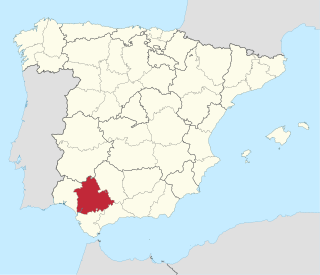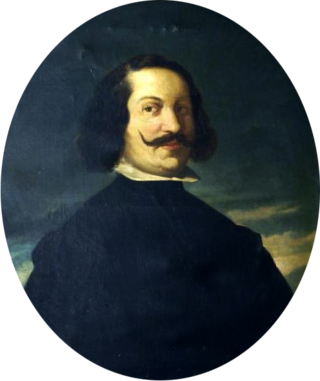
Isidore of Seville was a Hispano-Roman scholar, theologian, and archbishop of Seville. He is widely regarded, in the words of 19th-century historian Montalembert, as "the last scholar of the ancient world".

Seville is the largest city of the Spanish autonomous community of Andalusia and the province of Seville. It is situated on the lower reaches of the River Guadalquivir, in the southwest of the Iberian Peninsula.

The Guadalquivir is the fifth-longest river in the Iberian Peninsula and the second-longest river with its entire length in Spain. The Guadalquivir is the only major navigable river in Spain. Currently it is navigable from Seville to the Gulf of Cádiz, but in Roman times it was navigable from Córdoba.

The Province of Seville is a province of southern Spain, in the western part of the autonomous community of Andalusia. It borders the provinces of Málaga and Cádiz in the south, Huelva in the west, Badajoz in the north and Córdoba in the east. Seville is the province's as well as the Andalusian autonomous community's capital.

Mateo Alemán y del Nero was a Spanish novelist and writer.

Bartolomé Esteban Murillo was a Spanish Baroque painter. Although he is best known for his religious works, Murillo also produced a considerable number of paintings of contemporary women and children. These lively realistic portraits of flower girls, street urchins, and beggars constitute an extensive and appealing record of the everyday life of his times. He also painted two self-portraits, one in the Frick Collection portraying him in his 30s, and one in London's National Gallery portraying him about 20 years later. In 2017–18, the two museums held an exhibition of them.

Joaquín Turina Pérez was a Spanish composer of classical music.

Francisco Guerrero was a Spanish Catholic priest and composer of the Renaissance. He was born and died in Seville.

The Seville Metro is an 18-kilometre (11 mi) light metro network serving the city of Seville, Spain and its metropolitan area. The system is totally independent of any other rail or street traffic. All 22 stations were built with platform screen doors.

The Spanish Golden Age was a period coinciding with the political rise of the Spanish Empire under the Catholic Monarchs of Spain and the Spanish Habsburgs when literature and the arts flourished in Spain. During this time, the greatest patron of Spanish art and culture was King Philip II (1556–1598), but the period is also more broadly associated with the reigns of Isabella I, Ferdinand II, Charles V, Philip II, Philip III, and Philip IV, when Spain was at the peak of its power and influence in Europe and the world.
Yom Tov ben Abraham of Seville commonly known by the Hebrew acronym Ritva, was a medieval rabbi and rosh yeshiva of the Yeshiva of Seville, known for his commentaries on the Talmud.

The Cathedral of Saint Mary of the See, better known as Seville Cathedral, is a Catholic cathedral and former mosque in Seville, Andalusia, Spain. It was registered in 1987 by UNESCO as a World Heritage Site, along with the adjoining Alcázar palace complex and the General Archive of the Indies. It is one of the largest churches in the world as well as the largest Gothic church.

Estadio Benito Villamarín is a stadium in Seville, Spain, and the home of Real Betis since its completion in 1929. It has a capacity of 60,720.

Seville Airport is the sixth busiest inland airport in Spain. It is the main international airport serving Western Andalusia in southern Spain, and neighbouring provinces. The airport has flight connections to 19 destinations in Spain and 55 destinations around the rest of Europe and Northern Africa, and handled 8,071,524 passengers in 2023. It serves as a base for the low-cost carriers Vueling and Ryanair. It is 10 kilometres (6.2 mi) east of central Seville, and some 110 kilometres (68 mi) north-east of Costa de la Luz. Seville Airport is also known as San Pablo Airport to distinguish it from the older Tablada Aerodrome, which was in operation as a military aerodrome until 1990.

Juan de Valdés Leal was a Spanish painter and etcher of the Baroque era.

The Plaza de España is a plaza in the Parque de María Luisa, in Seville, Spain. It was built in 1928 for the Ibero-American Exposition of 1929. It is a landmark example of Regionalism Architecture, mixing elements of the Baroque Revival, Renaissance Revival and Moorish Revival (Neo-Mudéjar) styles of Spanish architecture.

The Seville Expo '92 was a universal exposition that took place from Monday, April 20 to Monday, October 12, 1992, on La Isla de La Cartuja, Seville, Spain. The theme for the expo was "The Age of Discovery", celebrating the 500th anniversary of Christopher Columbus reaching the Americas after launching from Seville's port, and over 100 countries were represented. The total amount of land used for the expo was 215 hectares and the total number of visitors was 41,814,571. The exposition ran at the same time as the smaller and shorter-duration Genoa Expo '92, a Specialized Exhibition, held in memory of Christopher Columbus, born in Genoa.

The Taifa of Seville was an Arab kingdom which was ruled by the Abbadid dynasty. It was established in 1023 and lasted until 1091, in what is today southern Spain and Portugal. It gained independence from the Caliphate of Cordoba and it expanded the territory it ruled in the mid-11th century. The emerging power of Castile led Seville to ask military assistance from the Almoravids, who then occupied Seville.

The Young Beggar is a genre painting by Spanish painter Bartolomé Esteban Murillo. Also known as The Lice-Ridden Boy due to the figure of a young boy delousing himself in the painting, The Young Beggar is the first known depiction of a street urchin by Murillo.
Myriam Seco Álvarez is a Spanish archaeologist and Egyptologist. A distinguished authority in those fields, the author of several reference books, and responsible for excavations in the Middle East and Egypt, she has launched and directed important archaeological projects, including the excavation and restoration of the mortuary temple of Pharaoh Thutmose III. The so-called "Spanish Indiana Jones", she has had a prolific professional career and a broad international presence.

















